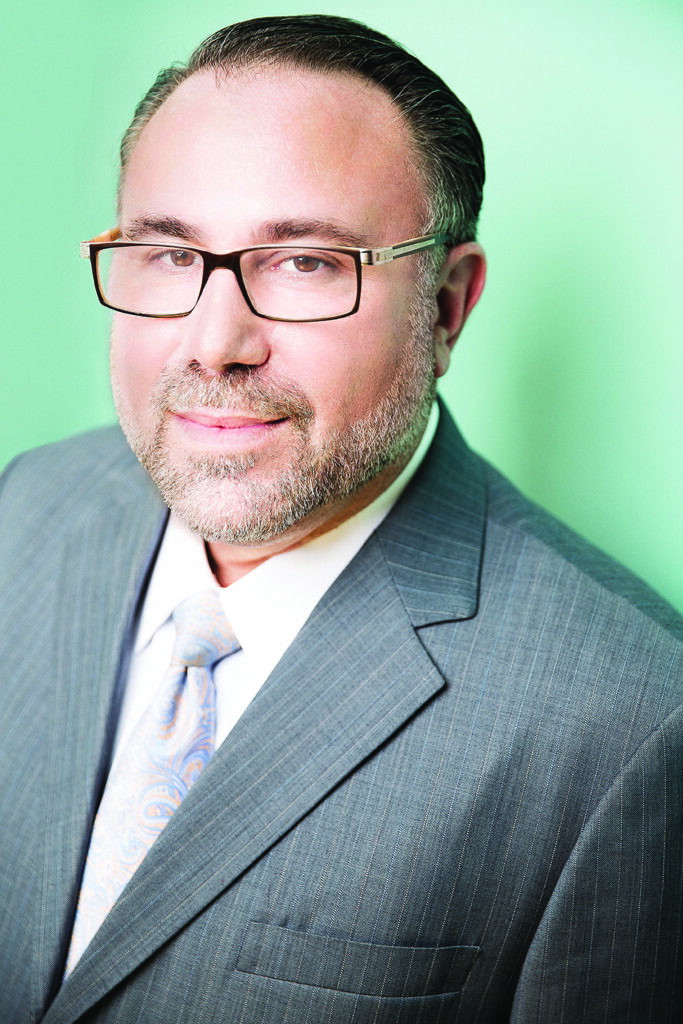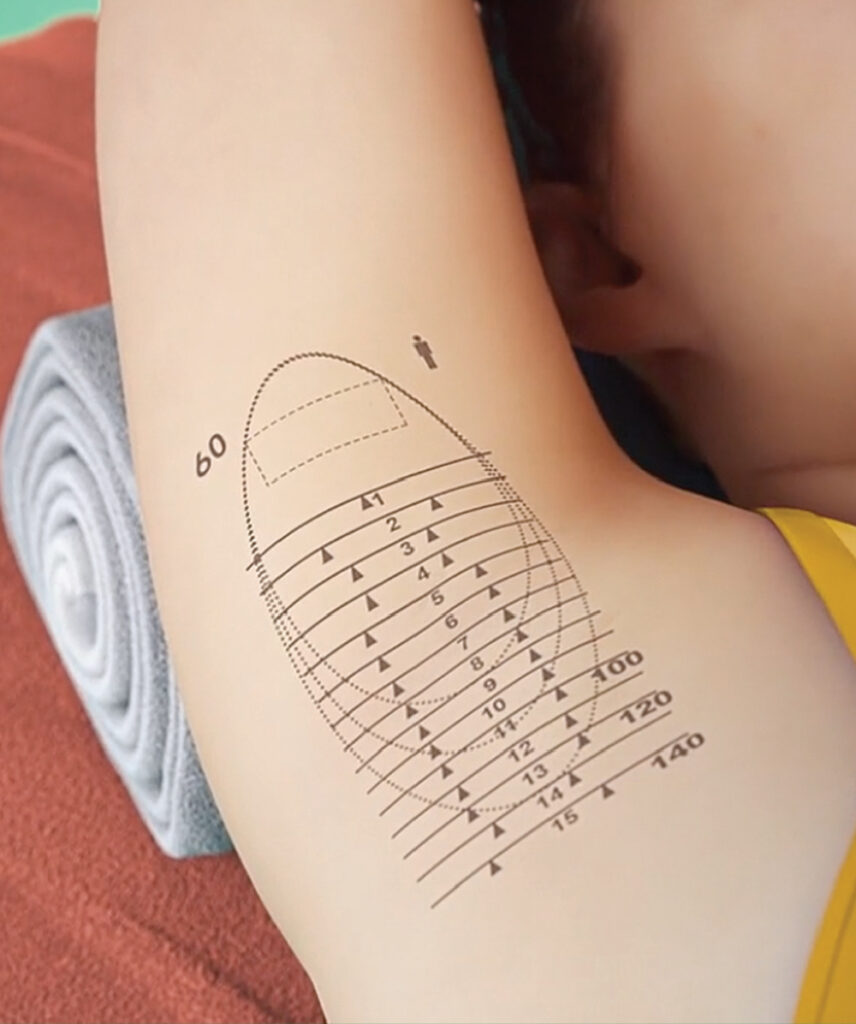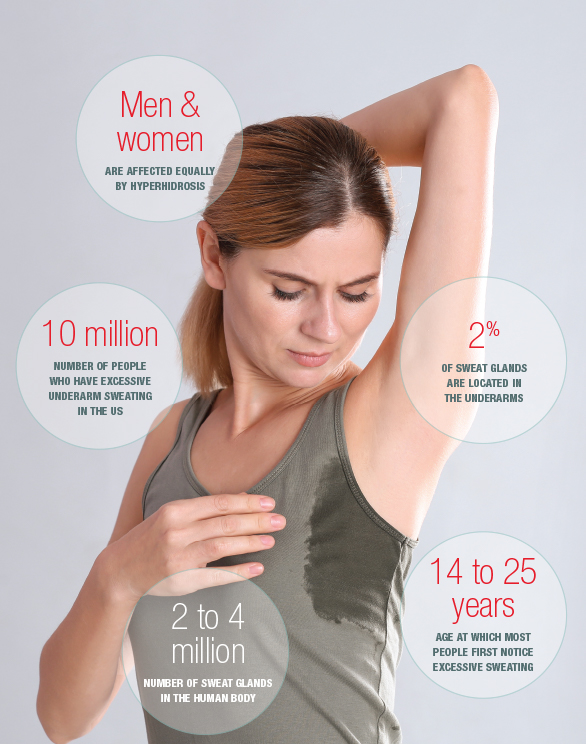
Michael Gold, MD, with Bob Kronemyer
Despite having at our disposal highly effective old and new medications to treat hyperhidrosis, ranging from topical aluminum chloride hexahydrate (Drysol, Person & Covey, Inc.) to the glycopyrronium cloth (Qbrexza, Dermira), medical devices still have a place.
However, there is currently only one FDA-cleared device for axillary hyperhidrosis: miraDry (Sientra). This noninvasive treatment, which uses microwave technology to eliminate sweat and odor glands from the armpits, was approved in 2015. The in-office therapy uses a handheld applicator to deliver electromagnetic energy below the skin, where it targets and destroys the sweat glands. In addition, the handpiece provides cooling to lessen patient discomfort. There is no question that miraDry provides permanent sweat reduction in nearly all patients.
Performing a miraDry procedure
To prepare the patient, a grid pattern is placed on the underarms (see Figure).

A local anesthetic is also applied to the area, using tumescent anesthesia for the whole axillary region, so it is fairly simple to administer. Microwave energy is absorbed by molecules that are electric dipoles, which rotate as they try to align themselves with the alternating field of microwaves. Rapid molecular rotation generates frictional heat. Microwaves are preferentially absorbed by high water-content tissue, such as sweat glands, leading to localized heating. And when temperatures in the target tissue reach critical levels, cellular thermolysis occurs.
The system has a tap-and-release button on the handpiece that initiates treatment and minimizes user fatigue. There are also indicator lights when energy is activated. Safe use of higher energy produces greater efficacy and high patient satisfaction in as little as one treatment.
The procedure takes approximately 30 minutes to 1 hour to perform. Once the numbing wears off, there is a slight soreness to the area. The free-standing miraDry is an appealing option for those patients who do not want to take a pill or do not want to use a topical every single day.
The biggest hurdle, however, is that the procedure is not covered by insurance, which can cost the patient several thousand dollars for one treatment, depending on where the patient lives.
MiraDry is always given as an option for hyperhidrosis at my office. Almost all patients require only one treatment session, with a few patients choosing a second treatment 3 to 6 months later. It is patient preference whether they want a second treatment. Most opt not to. When the device first came out many years ago, we recommended one treatment only. But then we realized there is a small group of patients, probably less than 10%, that need a second treatment. For those people, miraDry is a good option.
Besides the need for anesthesia in all patients, there are rare cases of burning and blister formation. However, I have never seen any scarring from the device, although I am sure it has been reported. With the right skill set to perform the procedure, it should be a truly simple procedure and user-friendly. Once the area is anesthetized, you just follow the grid pattern that is provided with the system.
It costs about $80,000 for a practice to acquire miraDry, for which I charge $2,500 for the first treatment and about $1,500 for a second treatment. I delegate the procedure to one of my staff, under my supervision. In today’s world, it is important to have physician supervision for these kinds of procedures.
Other options
Other devices have been used for many years to treat people with sweating, primarily radiofrequency (RF) systems that we also use for skin tightening. These companies claim that their RF systems have sufficient RF energy to penetrate the sweat glands and destroy sweat. But in my experience, I have never found any of these devices to be that effective at this process.
In the United States, it is not very common for RF systems to be promoted to treat hyperhidrosis. An example is the SweatX system (Alma Lasers) from several years ago, which never came to America. But some people thought that it worked really well because it was RF-based heating.
One topical medication for hyperhidrosis that has been used for a long time is glycopyrrolate (Robinul, Casper Pharma). However, usually patients who have successful therapy with glycopyrrolate also experience excessive dryness in every part of their body, which becomes an issue for many patients. Therefore, I recommend this drug in extreme cases only.
The botulinum toxin Botox (Allergan) also has an FDA indication to treat hyperhidrosis of the axilla. But a practice can choose whatever toxin it prefers because they all possibly work similarly, although Botox is the only toxin that has had clinical work and several large clinical studies. Also, occasionally Botox is covered by insurance, even though at times reimbursement is less than the cost of the Botox itself. So you need to be aware of the costs and reimbursements in the insurance world. By filing for insurance, you are sometimes contractually obligated to accept what the insurance pays.
Furthermore, a Botox injection lasts roughly 6 months, give or take 1 month, in most patients, before a repeat injection is needed.
Patient procedures
When a patient comes into my office with hyperhidrosis, I go through the treatment algorithm with him or her. For a patient with medical insurance, the insurance company usually requires that treatment begin with topical aluminum chloride hexahydrate in a prescription strength. However, most patients fail this treatment, even though it has been around for a long time.
Our back-up treatment is a glycopyrronium cloth or Botox. But we always bring miraDry into the equation from day one. Some patients have already tried everything else, so they want miraDry immediately. For chosen treatment, results may last for a really long time, while others may obtain results that last only a few months. But for those who sweat profusely and achieve a few months of relief, it is well worth it.
To market miraDry at our practice, we have offered a promotion called “miraDry Mondays” for several years now. We like to treat one or two patients every Monday. Patients who commit to a single treatment are given a discount on a second treatment, if needed. Overall, between 10% and 15% of my hyperhidrosis patients choose miraDry. Some patients even request it by name because of the company’s selective advertising.
For the right patient, who is miserable with primary axillary hyperhidrosis, miraDry is definitely a game changer.
Michael Gold, MD, is Medical Director, Gold Skin Care Center and Tennessee Clinical Research Center, Nashville, Tennessee.
DISCLOSURES
Dr. Gold reports no relevant financial interests.


